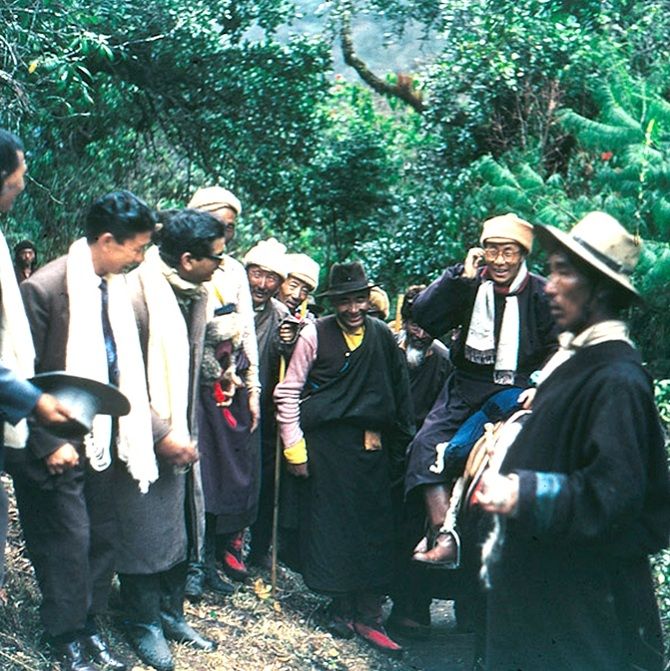The Indian government decided to ignore the Tibetan issue, probably due to a lack of vision and courage, despite the warnings of Sardar Patel and his colleagues.
This move would have tremendous consequences; some that continue to be felt even 70 years later, on the northern borders of India, particularly in eastern Ladakh, points out Claude Arpi.

Seventy Years Ago: Tibet 'Liberated'
October 7, 2020, marked the 70th anniversary of the Chinese People's Liberation Army crossing the Upper Yangtze and entering into the territory controlled by Lhasa.
Twelve days later, on October 19, Chamdo, the capital of the Kham province, fell in the hands of the Communists; Beijing then announced that it had started 'liberating' The Land of Snows.
For someone born in France, 'liberation' has another meaning; as a kid, I often heard General de Gaulle's historic speech as he entered Paris in August 1945: 'Paris! Paris outraged! Paris broken! Paris martyred! But Paris liberated! Liberated by itself, liberated by its people with the help of the French armies, with the support and the help of all in France, of the France that fights, of the only France, of the real France, of the eternal France!'
Today, seven decades later, the Tibetans still do not understand why they needed to be 'liberated' and from what.
In fact, since then, they live in a state of slavery of another kind.
Tragically, in the process, India lost a peaceful border shared with a gentle Buddhist nation.
The Fall Of Chamdo
The Battle of Chamdo, the first and only encounter between the Tibetan and Chinese forces, is interesting to look at for several reasons.
Tibet, a Buddhist nation was not militarily or tactically ready to oppose the seasoned troops of Mao (and some of China's brilliant commanders).
From the start, The Land of Snows stood no chance, especially without outside support from India or the West.
Further, many in Tibet still believed that increasing the number of japa (recitations) or parikramas (circumambulations) around the monasteries and stupas of Kham would be sufficient to make the truth prevail.
As Robert Ford, the British radio operator posted in Chamdo, remarked, 'The gods are on our side' was the mantra most oft-repeated in the town, but it seemed to me that something more Churchillian was needed.'
For the Chinese, it was a well-prepared operation (a 'police operation' Marshal Peng Dehuai would have said) in two stages: The fall of Chamdo, the capital of Kham province during the Fall of 1950, and then the advance to Lhasa after the winter.
India was fooled into believing that Communist China wanted a 'negotiated' settlement with the Tibetans: it was never the case.
Marshal Liu Bosheng, in a message in August 1950, made it clear that he was going to 'liberate' Tibet.
Opposite the Chinese strategists was Ngabo Shape, the Tibetan commissioner for the Kham province, a weak leader ready to surrender; he was obviously not the military chef de guerre that Tibet needed at that point in time to coordinate the defence of the different border posts.
It has to be noticed that Mao Zedong entered the Korean campaign on October 7, the same day that the PLA crossed the Yangtze and started its operations in Tibet.
It shows the confidence the Communist leadership had in the local PLA commanders.
The PLA summary of the battle and the recommendations distributed by the PLA after the Battle of Chamdo show that it was considered as an excellent preparation for the Chinese troops for another battle, 12 years later on the Himalayan slopes.
Against India this time!

Still Not Free
Today, China speaks of 'poverty alleviation' for the Roof of the World, but what has the Communist regime been doing since they entered Chamdo in October 1950 if the Tibetans have remained poor 70 years later?
The truth is that Mao was only interested in the strategic assets of Tibet; China gained not only a huge landmass but access to the 'water tower of Asia', large mineral resources and a strategic position dominating the subcontinent.
The Tibetan people figured nowhere in China's objectives.
At that time, the Indian government decided to ignore the Tibetan issue, probably due to a lack of vision and courage, despite the warnings of Sardar Patel and his colleagues.
This move would have tremendous consequences; some that continue to be felt even 70 years later, for example, on the northern borders of India, particularly in eastern Ladakh.

A Genuine Autonomy
In a note in November 1950, Nehru frankly admitted that though Beijing had repeatedly expressed itself in favour of Tibetan autonomy 'but of course we do NOT know what their idea of autonomy is'.
However, he believed: 'We do NOT think that legal argument will be helpful or that (the General) Assembly should attempt more than appeal to (the) two parties to come to a peaceful settlement. Condemnation of China will NOT help Tibet; and neither (the) Security Council nor (the) Assembly is in any position to render physical aid to Tibet.'
As a result, China was not condemned and could complete its task of entering Lhasa without hindrance in September 1951; in Sun Tzu's jargon, 'liberating Tibet without waging war'.

The Tibetan Uprising
The Tibetans soon realised that they had not been 'liberated'.
On June 1, 1959, Major S L Chibber, the Indian consul general in Lhasa, sent his report about the tumultuous months of March, April and May 1959 to the ministry of external affairs in Delhi; he described the events which led the Tibetan nation to rise against the occupiers.
This is a unique and remarkable document as it is the only eye-witness account by a 'foreigner'; without it we would have only the Chinese propaganda version ('they emancipated the serfs').
Chibber first described the background and the happenings in Kham in 1955/56: 'During (the) operations, (a) number of monasteries were destroyed and the local people suffered heavy losses. Due to (the) absence of proper means of communication and security measures adopted by (the) Chinese to suppress the information, the correct news of happenings in these areas-seldom reached outside world.'
The leaders in Beijing were already masters at covering up the truth; is it different today?
Chibber continued: 'However, whatever little news trickled through traders and travelers contained horrible accounts of atrocities committed by the Chinese against the people of these areas, especially against the lamaseries. This naturally had an effect on the minds of Tibetans elsewhere and a stage had reached that some among these Tibetans who had thrown their lot with the Chinese previously... doubted Chinese promises of respect for religion and internal autonomy.'
The consul said that, finding it difficult to face frontal attacks from the Chinese troops, the Khampas resorted to guerrilla tactics and 'moved towards the south where the Chinese garrisons were few and far between and the difficult terrain suited to hit and run type of war'.
The rejection of the Chinese occupation by the Tibetan population was the turning point in the history of modern Tibet, which eventually witnessed the uprising of the Tibetan masses on March 10, 1959, in Lhasa and the departure of Tibet's temporal and spiritual leader into exile.

Major Chibber's first-hand account is important because the Chinese propaganda would like us to believe that during, those dramatic weeks of March 1959, they 'emancipated' the serfs.
But in fact, the opposite happened; recounting the events that he witnessed in Lhasa, Chibber observed: 'In the history of movement for free Tibet, the month of March 1959 will be most historic as, during this month, Tibetans high and low in Lhasa, the capital of Tibet, openly challenged the Chinese rule in Tibet. They set up an organisation called Pho Mimang Ranchen Chi Chog, meaning Tibetan Peoples Independent Organisation; renounced the Sino-Tibetan Agreement of 1951; staged demonstrations to give vent to their anti-Chinese feelings and demanded withdrawal of the Chinese from Tibet.'
The Indian consul general also mentioned the 'might' of the Chinese People's Liberation Army 'who, on March 20, 1959, started an all-out offensive against the ill-organised, ill-equipped, untrained-Tibetans with artillery, mortars, machine guns and all types of automatic weapons'.
The revolt was short-lived: 'His Holiness the Dalai Lama, smelling danger, left Lhasa secretly on the night of the March 17, 1959, with important members of his personal staff, three cabinet ministers and members of his family for (the) Lhoka area (south of Lhasa), where at that time Khampas had full sway and from where it was easier for him to escape to India if need arose,' noted Chibber.
On March 28, 1959, the Chinese state council dissolved the 'local' Tibet government; the Tibetan Kashag (cabinet) was no more and its functions and powers were transferred to the Preparatory Committee for the Tibetan Autonomous Region.
A Chinese communique announced that the Panchen Lama would be acting chairman 'for the period the Dalai Lama was held in duress'.
The Chinese propaganda wanted the world to believe that the Dalai Lama had been kidnapped by the CIA and later kept 'under duress' in India.
A military control commission was established in Lhasa on March 23, 1959.
Chibber also remarked that the Chinese transport department's passenger service between Yatung, Shigatse, Gyantse and Lhasa had been stopped several months earlier.
A dusk-to-dawn curfew was promulgated, while meetings to criticise the former Tibetan government, the 'imperialists' and the Indian 'expansionists' were organised to denounce their interference in the internal affairs of Tibet.
Military control commissions were also installed in other areas in Tibet, particularly on India's frontier.
It is how Tibet was brutally 'liberated'. One should never forget.
Claude Arpi is a long-time contributor to Rediff.com.
Feature Presentation: Aslam Hunani/Rediff.com












 © 2025
© 2025